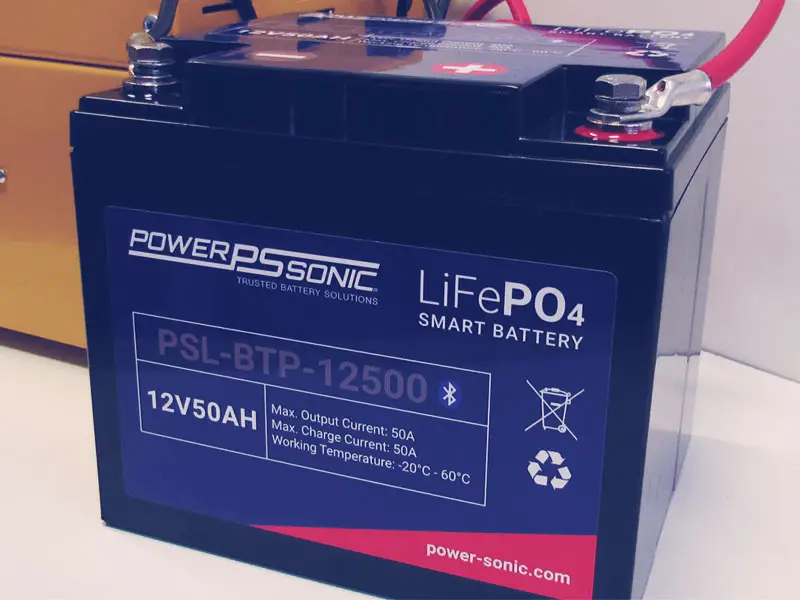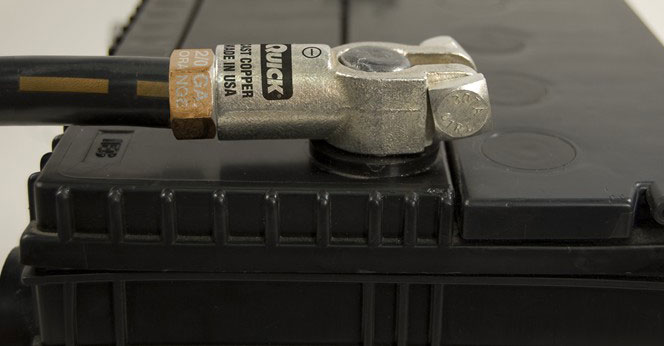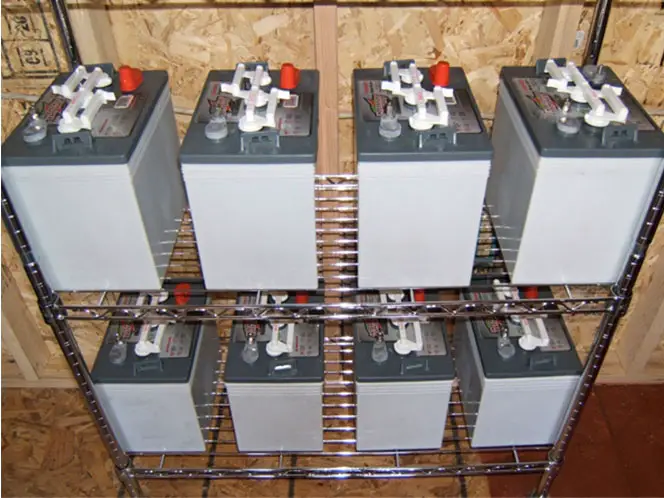let’s dive deeper and see how you should store your LiFePO4 battery.
How To Store LiFePO4 Batteries?
You must keep LiFePO4 batteries in a cool and dry place inside your house during the off-season. Always store the battery fully charged or at least 50% or higher state of charge (SOC). Make sure the temperature is between -5°C and 35°C.
Here’s a step-by-step process on how to store a LiFePO4 battery.
Step 1: Charge Your Battery Up To 100%
You should fully test and charge your LiFePO4 battery before storing it. [you can use an external power supply if you want] Your LiFePO4 battery, when stored at the right temperature, will self-discharge 2% per month. So, if you plan to store your battery for a long time, fully charge your battery first.

Even if you cannot fully charge it, at least make sure it has 50% more state of charge. So, it won’t go down to the cutoff point. If you store a fully discharged LiFePO4 battery, it will go further down the cutoff point.
It won’t be a good consequence for your battery. If you are lucky, the battery will go to sleep mode. But in the worst-case scenario, it might get irreversibly damaged. So, do not take the bet and charge it fully before storing your LiFePO4 battery.
Step 2: Removes Any Loads & Connections
You have to remove all the loads and power from your LiFePO4 battery while storing. A lot of people use the main switch to disconnect the battery power.
Some loads bypass the main switch and consume energy from the battery in the background. So, even though you are storing your battery, some of them will keep discharging your battery if you do not disconnect them.

A LiFePO4 battery has a 2% self-discharge rate per month while storing. But to prevent it from higher discharge, you will have to remove all the loads and connections from your battery.
Step 3: Store the Battery Somewhere Dry & Cool
If you want to store your LiFePO4 battery unused, whether, for the short term or a long term, you must keep it in the right place. Do not just keep it in your garage or outside.

Keep your LiFePO4 battery inside, in a cool and dry place. Make sure the temperature is within the recommended range. Moisture can damage battery cells. That’s why no matter what, your battery cannot come in touch with rainwater or snow.
Venting LiFePO4 batteries while storing is not a crucial requirement.
So, make sure- the place where you are storing your battery is not dampened or has any chance of it.
Step 4: Ensure Proper Storing Temperature
Temperature is very crucial for storing any battery, including the LiFePO4 battery. You must be extra cautious about the temperature, as it greatly affects your battery. Generally, the recommended temperature for storing LiFePO4 batteries is -5°C to 35°C.
But if you want to store it for a long, you must plan beforehand. Because the temperature will vary based on how long you want to store your battery unused.
If you store your battery for up to 1 month, the temperature range can be -20°C to 60°C. But you want to store your LiFePO4 battery for up to 3 months; the temperature should be within -10°C to 35°C.
But, if you plan to store your LiFePO4 battery for much longer, you have to make sure the battery is within 15°C to 35°C temperature.
Here’s a list summarizing the temperature ranges of various duration.
| Duration | Temperature |
| In General | -5°C to 35°C |
| Up to 1 Month | -20°C to 60°C |
| Up to 3 Months | -10°C to 35°C |
| For Longer Period | 15°C to 35°C |
Step 5: Cycle Your Battery Every 6 Months for Long-Term
Finally, while storing your battery for a long, cycle it once every 6 months. Otherwise, you won’t get a good charge capacity from your battery, when the storage period is over.
LiFePO4 battery self-discharges itself at a 2% rate per month. So, you have to cycle it after 6 months and fully charge it again.
Because if your battery voltage level gets too lower by self-discharging while storing, it will not give you the capacity like before.
What does Extreme Cold Temperature do to Your LiFePO4 Battery?
Although extreme temperature does not affect a LiFePO4 battery if you are not using it, manufacturers recommend not storing batteries in extremely cold temperatures for a long time.
Because it might crack the ABS casing of your LiFePO4 battery, storing the LiFePO4 battery for long terms under 0°C will make it discharge itself at a more than 2% rate.
Plus, your battery will have system loss. If you start using it, a 12V 100Ah LiFePO4 battery will only provide 90Ah or even as low as 70Ah.
However, it’s a temporary condition and will go away when the temperature rises. Based on a study, LiFePO4 battery capacity can be reduced to 70% if you store and use it in extremely cold temperatures.
Most importantly, charging and storing your LiFePO4 batteries at a freezing temperature for a long time will cause lithium plating. It’s very destructive for lithium batteries and can cause a short circuit.
Protection From Cold Temperature
The most convenient solution is to store your battery at the right temperature. The room temperature will be an ideal condition to store your LiFePO4 batteries. Besides, you can also protect your battery from lithium plating by maintaining the temperature.
Do not charge your battery at freezing temperatures after a storage cycle. Make sure the temperature is around 15°C.
What does Extreme Hot Temperature do to Your LiFePO4 Battery?
The extreme hot temperature has similar effects on your LiFePO4 battery as extreme cold temperatures do.
Eventhough LiFePO4 doesn’t catch fire esily, storing your LiFePO4 battery in extremely hot temperatures for a long time may damage the components inside your battery pack.
According to a research paper, high temperatures reduce battery capacity. So, by storing your battery at a higher temperature than 35°C, you will get reduced capacity. Your battery will face an over-discharge rate, internal short circuit, etc.
Protection From Hot Temperature
To protect your LiFePO4 battery from hot temperatures while storing it, you have to keep it somewhere cool. You can keep it under a fan or air conditioner. Also, check the voltage with a voltage meter and see whether it’s in the right amount.
You must purchase a correct BMS and use it with your LiFePO4 battery pack. It will look after your battery. If the temperature goes too high, the BMS will take adequate action like sending your battery to sleep mode.
What Happens to LiFePO4 Battery After Long-Term Storage?
LiFePO4 battery has long-lasting battery chemistry. That’s why you can store them for a long time. If you store your battery correctly, it won’t have any issues after storing it for a long time.
But you may have many issues with temperature, voltage, and discharge rate. Because of the temperature imbalance and high discharge rate, a LiFePO4 battery may give less capacity than before. It might take time to wake up.
Possible Solutions
If your battery won’t take charge after long-term storage, you will have to wake up your LiFePO4 battery. You can use a power supply connected to your battery for a few seconds.
Plus, cycle your battery every 6 months while storing it for a long time. After storing your battery for a long time, it might give reduced capacity at the beginning, but it will be okay over time.

Eng. Matthew Joseph Nandirio is the Founder of walkingsolar.
After graduating from the University of Houston in 2002, matt started working as a Solar Electrical Engineer for several multi-national solar energy companies.
He has a wide range of experiences including solar system requirement analysis, planning, maintaining, debugging and even solar device development through research.
He now shares his 20 years of expertise through his articles on the walkingsolar website.
Further, he is also the author of two books on Solar Technology, “Solar Power for Villages” and “DIY Solar System for Dummies”.

